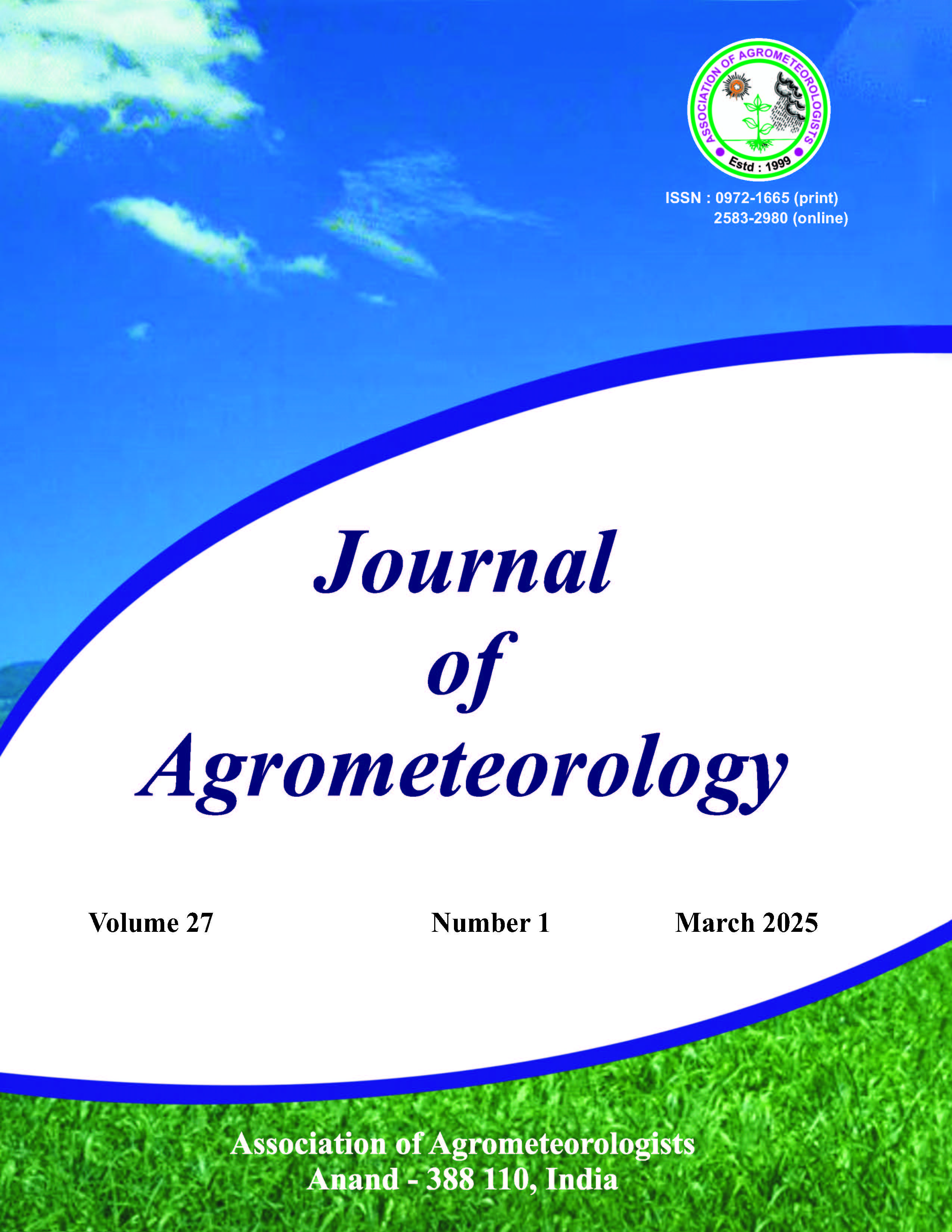Relationships between daily solar irradiance and maximum temperature in Iraq
DOI:
https://doi.org/10.54386/jam.v27i1.2708Keywords:
Solar irradiance, Maximum temperature, POWER data, Correlation, Regression, IraqAbstract
This study investigates the relation between daily solar irradiance (SI) and maximum air temperature (Tmax) over six cities in Iraq (Basra, Shanafiya, Baghdad, Rutba, Kirkuk, and Shakhan) using NASA POWER data for the period 2014-2023. Results revealed that in the arid southern provinces such as Basra, the annual mean SI exceeds 5.6 kWh m-2day-1 and Tmax frequently exceeds 48°C during the summer months while in the northern provinces lower SI and Tmax values were observed. The seasonal variation indicated peak values of SI during June while peak values of Tmax were observed in July-August. A strong relationship between SI and Tmax were obtained with R2 of 0.75 to 0.82 at different locations.
References
Al Rukabie, J. S., Naif, S. S. and Al-Jiboori, M. H. (2024). Quantitative impact of monthly precipitation on urban vegefation, surface water and potential evapotranspiration in Baghdad under wet and dry conditions. Nature Environ. and Pollut. Tech., 23(4): doi:10.46488/NEPT.2024.v23i04.041
Al-Jiboori, M.H., Abu-Shaeer, M.J. and Hassan, A.S. (2020). Statistical forecast of daily maximum air temperature in arid areas at summertime. J. Mat. Fund. Sci., 52(3): 353-365.
Al-Samarrai, H. M., Al-Jiboori, M. H. (2023). Prediction of daily maximum air temperature for transitional seasons by statistical methods in Baghdad. Iraqi J. Sci., 64(4): 2085-2094. doi:10.24996/ijs.2023.64.4.42
Anad, A.M., Hassoon, A. F. and Al-Jiboori, M. H. (2022). Assessment of air pollution around Durra refinery (Baghdad) from emission NO2 gas at April month. Baghdad Sci. J., 19(3): 515-527. doi:10.21123/bsj.2022.19.3.0515
Ben Amara, M., Rdhaounia, E. and Balghouthi, M. (2024). Adaptive solar irradiance forecasting in arid regions: Enhancing accuracy with localized atmospheric adjustments. J. Eng. Res. doi:10.1016/j.jer.2024.07.008
Daut I, Yusoff M. I., Ibrahim S., Irwanto, M. and Nsurface, G. (2012). Relationship beteen the solar radiation and surface temperature in Perlis. Adv. Materials Res., 512-515, 143-147. doi:10.4028/www.scientific.net/AMR.512-515.143
Deagan, E .A., Al-Jiboori, M. H. (2023). The relationship of CLWC and rainfall to the synoptic cases of two case studies over Iraq. 4th International conference of Modern Technologies in Agricultural Sciences. 1262. IOP Conf. Series: Earth and Environ. Sci. doi:10.1088/1755-1315/1262/8/082018
Gómez, I., Molina, S. and Galiana-Merino, J. J. (2023). Evaluating the influence of air pollution on solar radiation observations over the coastal region of Alicante (Southeastern Spain. J. Environ. Sci., 126: 633-643. doi:10.1016/j.jes.2022.05.004
Haraj, S. A. and Al-Jiboori, M. H. (2019). Study of aerodynamic surface roughness for Baghdad City using signal-level measurements. Baghdad Sci. J., 16(1)Supplement, 215-220. doi:10.21123/bsj.2019.16.1(Suppl.).0215
Ibrahim, S., Daut, I., Irwan Y.M., Irwanto, M., Gomesh, N., Farhana, Z. (2012). Lineat regression mondel in estimating solar radiation in Perlis. Energy Procedia, 18: 1402-12. doi:10.1016/j.egypro.2012.05.156
Jed, M., Ihaddadene, N., Jed, M.E., Ihaddadene, R. and El Bah, M. (2022). Validation of the accuracy of NASA solar irradiation data for four African Regions. Int. J. Sustain. Develop & Planning 17: 29-39. doi:10.18280/ijsdp.170103
Lawin, A. E., Niyongendako, M. and Manirakiza, C. (2019). Solar irradiance and temperature variability and projected trends analysis in Burundi. Climate, 7: 83. doi:10.3390/cli7060083
Mahdi, Z. S., Tawfeek, Y. Q., Al-Jiboori, M. H. (2024). Relationship between monthly surface water derived from Sentinel-2 imagery and meteorological data (precipitation and evaporation) at Baghdad, Iraq. Water Pract. & Tech., 19(5): 1794-1809. doi:10.2166/wpt.2024.098
Mendoza, B. (2004). Total solar irradiance and climate. Adv. Space Res., 35(5): 882-890. doi:10.1016/j.asr.2004.10.011
Mina, U., Singh, S. D., Singh, B. And Khaund, M. (2015). Response of wheat and chickpea cultivars to reduced levels of solar irradiance. J. Agrometeorol, 17(2): 165–171. https://doi.org/10.54386/jam.v17i2.998
Muter, S.A., Al-Jiboori, M. H. and Al-Timimi, Y. K. (2024). Assessment of spatial and temporal monthly rainfall trend over Iraq. Baghdad Sci. J. doi:10.21123/bsj.2024.10367
Nasser, M. S., Al-Hassany, J. S., and Al-Jiboori, M.H. (2024). Assessment of air pollution dispersion during wet season: A case study of Rumaila Combined Cycle Power Plant, Basrah, Iraq. J. Agrometeorol, 26(4): 411–418. https://doi.org/10.54386/jam.v26i4.2756
Odejobi, O. A., Alawode, K. O. and Lawal, M. O. (2024). Efficient Method For Forecasting Solar Irradiance - A Review. FUDMA J. Sci., 8(6): 285-298. doi:10.33003/fjs-2024-0806-2786
Tan, G., Afrouzi H.N., Ahmed, J., Hassan, A. and M-Sukki, F. (2024). Analyzing meteorological parameters using Pearson correlation coefficient and implementing machine learning models for solar energy prediction in Kuching, Sarawak. Fut. Sustainab., 2(2): 20-26. doi:10.55670/fpll.fusus.2.2.3
Wahab B.I., Naif S.S., and Al-Jiboori M.H. (2022). Development of annual urban heat island in Baghdad under climate change. J. Env. Eng. Landscape manag., 30(1): doi: 10.3846/jeelm.2022.16374), 179-187.
Downloads
Published
How to Cite
License
Copyright (c) 2025 MOHAMMED HAZIM KHALEEL, JAMAL S. ABD AL-RUKABIE, MONIM H. AL-JIBOORI, ZAHRAA A. AL-RAMAHY

This work is licensed under a Creative Commons Attribution-NonCommercial-ShareAlike 4.0 International License.
This is a human-readable summary of (and not a substitute for) the license. Disclaimer.
You are free to:
Share — copy and redistribute the material in any medium or format
Adapt — remix, transform, and build upon the material
The licensor cannot revoke these freedoms as long as you follow the license terms.
Under the following terms:
Attribution — You must give appropriate credit, provide a link to the license, and indicate if changes were made. You may do so in any reasonable manner, but not in any way that suggests the licensor endorses you or your use.
NonCommercial — You may not use the material for commercial purposes.
ShareAlike — If you remix, transform, or build upon the material, you must distribute your contributions under the same license as the original.
No additional restrictions — You may not apply legal terms or technological measures that legally restrict others from doing anything the license permits.
Notices:
You do not have to comply with the license for elements of the material in the public domain or where your use is permitted by an applicable exception or limitation.
No warranties are given. The license may not give you all of the permissions necessary for your intended use. For example, other rights such as publicity, privacy, or moral rights may limit how you use the material.





